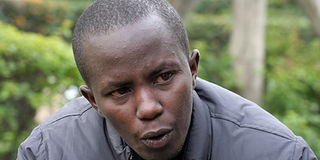Coping with drug-resistant tuberculosis

Mr Joseph Wanjohi, 29, who recovered from multi-drug resistant TB, during an interview at Kenyatta National Hospital. Photo/PHOEBE OKALL
What you need to know:
- Treatment of severe strain of the disease can cost up to Sh1.3m for every patient
After Joseph Wanjohi, 29, was diagnosed with tuberculosis in 2006, he started the prescribed drugs regimen.
But, his case was misdiagnosed only for him to later learn that he actually had the multi-drug resistant strain of the disease.
Then his father heard of cheaper drugs in Tanzania, and went to look for them there, only to learn that the area was too remote to carry his son who was bedridden at the time. Wanjohi gave up the idea of going to Tanzania and continued with the prescribed drugs.
Wanjohi’s case highlights the dilemma facing millions of Kenyans with the disease — and for those who will progress to a drugs-resistance variety.
Two years later, Mr Wanjohi was handed a clean bill of health and is now a TB ambassador, creating awareness on the disease and the importance of adhering to drugs.
Accelerate action
World TB Day, celebrated Wednesday, focuses on work to eliminate the disease which, according to the World Health Organisation, has infected a third of the world’s population.
This year’s theme, “On the move against tuberculosis: Innovate to accelerate action”, focuses on encouraging creative ways to fight, manage and control. According to WHO, drug resistance arises due to improper use of antibiotics in chemotherapy of drug-susceptible TB patients.
Improper use results from various reasons, including administration of improper treatment regimens by health care workers and failure to ensure patients complete the whole course of treatment.
Drug-resistant strains fail to respond to isoniazid and rifampicin, the two most powerful anti-TB drugs.
The global health body estimates that TB is the second greatest contributor among infectious diseases to adult mortality, causing about 1.7 million deaths a year worldwide.
“If ordinary tuberculosis is not treated properly, it could lead to development of multi-drug tuberculosis, which is difficult to treat, but if neglected further, it can lead to the extensively drug-resistant tuberculosis strain (XDR),” Dr H M Irimu, the Kenyatta National hospital head of TB care and treatment department, says.
The extensively drug-resistant tuberculosis variety is resistant to almost all drugs used to treat the disease, including isoniazid and rifampicin.
It is also resistant to the best second-line medications, and at least one of three injectable drugs.
Treatment of MDR TB costs about Sh1.3 million a patient.
Symptoms of this strain do not differ from those of ordinary TB, which include: weakness, weight loss, fever, and night sweats. When TB infects the lungs, one may have cough, chest pain, and may cough up blood.
Tuberculosis takes its greatest toll among the most productive age group of 15 to 44. Kenya ranks 13 of the 22 high burdened countries worldwide.
The country’s HIV epidemic is major contributing factor.
“The main challenge with TB is to improve awareness about the symptoms, encourage testing and assist patients complete their treatment,” said KNH’s Jotham Micheni in a recent tour of the hospital’s isolation ward.
TB treatment poses major challenges, particularly with the development of drug resistant strains of TB. The government spends less on a patient treating ordinary TB than treating drug-resistant TB.




